Alfalite is a Spanish company from Andalucia that is specialising in the design and manufacture of LED displays. At the moment, and for the last ten years, the displays have been made in China, but designed in Spain. However, the company is planning to start manufacturing in Spain later this year. The company has indoor and outdoor LEDs from 3.9mm with 1,800 cd/m² indoors and from 4.6mm (>6,000 cd/m²) for outdoor applications.
Displays have also proved popular in broadcast applications as well as rental and the company attributes this to its logistics and support. It offers 24/7 support in Spain and wants to extend its support to other territories.
Absen told us that as much as 65% of its LED business is in rental and staging in Europe. The company had an unusual stand design with cabinets hung from above and motorised so that they could be moved around. Most of the products at the event were the same as at ISE, but the NX7 floor panels were being highlighted.
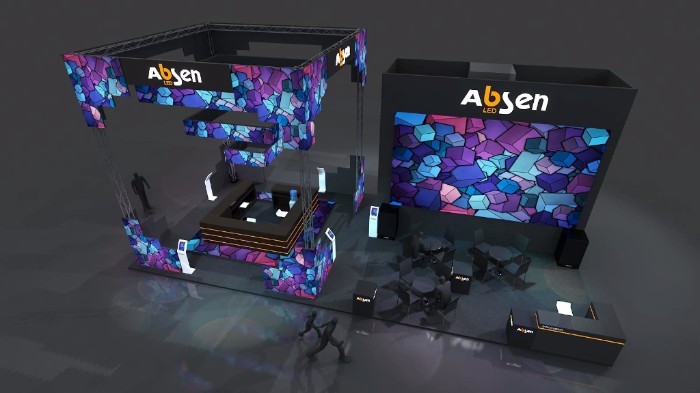 We also had a look at the company’s SmartLED concept which was being shown in a 2.9mm pitch. This uses a system of buttons and triggers to lock cabinets together making assembly a one person process and very rapid. Press the buttons and squeeze the triggers and cabinets are locked together. For maintenance, the power supplies are fixed without screws and can be simply clipped on. When the power supply is unclipped, the individual modules can be accessed from the rear of the cabinet.
We also had a look at the company’s SmartLED concept which was being shown in a 2.9mm pitch. This uses a system of buttons and triggers to lock cabinets together making assembly a one person process and very rapid. Press the buttons and squeeze the triggers and cabinets are locked together. For maintenance, the power supplies are fixed without screws and can be simply clipped on. When the power supply is unclipped, the individual modules can be accessed from the rear of the cabinet.
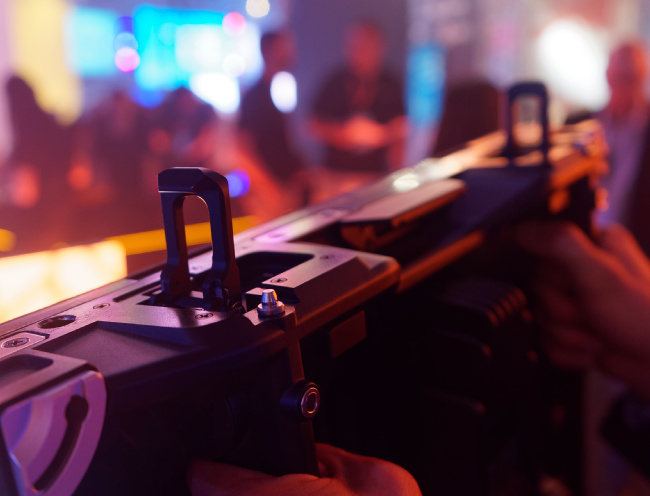
Aoto, who we have reported on regularly for some years, was highlighting a new 8mm outdoor rental system (the M8E) with 6,000 cd/m² of output and in a 480 x 480mm cabinet. Aoto was one of a number of companies that were emphasising new locking and docking systems and Aoto’s system uses four quick toggle levers in the corners to lock cabinets together very quickly.
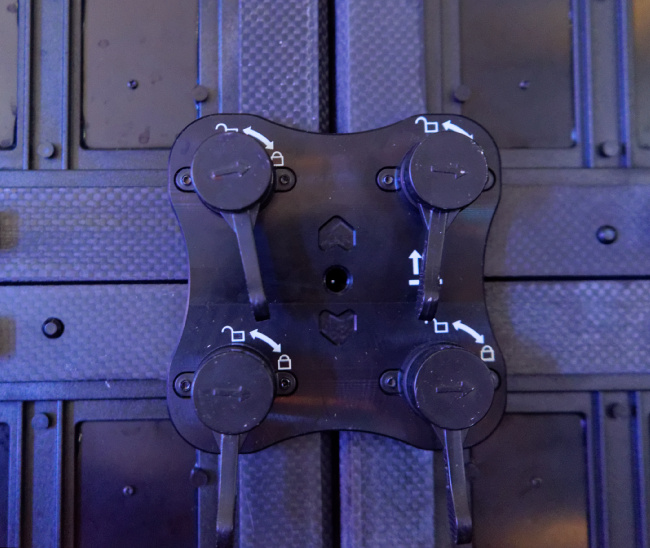 Aoto’s toggles can easily lock four cabinets. Image:Meko
Aoto’s toggles can easily lock four cabinets. Image:Meko
CreateLED is another Chinese (Shenzen) LED maker that specialises in indoor displays for rental and staging, with pixel pitches available from 1.6mm. It can also supply outdoor displays and fixed installation products. At the show it was highlighting how it could make life easier for installers and had a new ‘dolly’ that can load pre-assembled blocks of 2 x 2 cabinets to make setup easier.
An unusual feature of the cabinets on show was that they have been fitted with fold down ‘steps’ that can be used by riggers or installers to climb the rear of its cabinets without the need for a ladder, ideal if a repair needs to be made close to or during an event. Also on display from CreateLED were bigger cabinets for outside installation that are 100cm x 50cm and can be installed with an angle of 10 deg between cabinets. There are also flat versions available and the display on show was with 5.2mm pitch and 5,000 nits of brightness. The company also claimed especially high contrast and accurate colour performance from its products.
 CreateLED has a fold down foot step on the rear of its rental cabinets. Image:Meko
CreateLED has a fold down foot step on the rear of its rental cabinets. Image:Meko
LEDCon is a German company that specialises in LED display supply and was showing a new cabinet from one of its suppliers, Unilumin. The new cabinet has a design that (like CreateLED) has handles that can double as steps to allow the system to be climbed without a ladder. The modules are also designed so that they can be pushed out from the rear and passed back through the cabinet diagonally, to allow 100% maintenance from the rear. There were 2.6mm and 1.6mm Unilumin displays on show. The 2.6mm in a 50cm square cabinet has 192 x 192 pixels, so 10 cabinets horizontally allows FullHD support. Staff showed us the details of the magnetic system which uses eight magnets (two groups of four) which allow very precise adjustment to ensure very precise alignment.
 LEDCon told us that the Unilumin bars are intended for use as a step. Image:Meko
LEDCon told us that the Unilumin bars are intended for use as a step. Image:Meko
InfiLED is a Chinese (Shenzen) company that has its own office in Venlo on the borders of the Netherlands and Germany. It has a wide range of products for indoor and outdoor applications with pitches from 1.8mm to 50mm. Fixed installations are also a target market and the company highlighted that its outdoor displays are available right down to 4mm pitch. It also has floor displays. On its booth, the firm was showing it ‘touring cart’ which makes it very quick and easy to move rental and staging cabinets. Displays down to 2.4mm were shown on at the event, but we heard that 1.2mm pitch LED displays will be available from September.
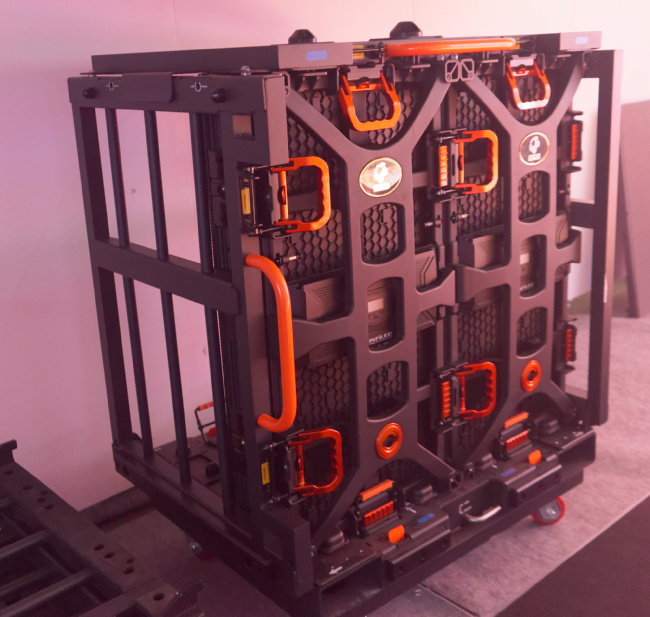 InfiLED was showing its new cart. Image:Meko
InfiLED was showing its new cart. Image:Meko
Gloshine was one of the many Shenzen-based companies at the event that were showing LEDs. The firm has been in the rental and staging market in China for more than 10 years, but was ‘late’ to the international market and it only started to move outside its home market around four years ago. It has had some success in the UK and in Germany and is setting up an office in the Netherlands, initially and the firm is looking for some international partners, still.
Gloshine positions itself in the ‘upper middle’ segment of the market and said that it is not the cheapest, but finds that its attention to issues such as EMC and CE mark approvals, especially in the very strict German market, helps it to develop a very stable client base. It focuses mainly on smaller pitch and has developed 1.6mm product (although production is not yet stable). The largest pitch is normally 10.4mm, although for special applications it can go to 15mm.
Leia Display Systems (http://tinyurl.com/mwg4ozs) has a mist-based rear projection system that it uses in ‘touch’ applications, using a Microsoft Kinect motion sensor. The company had a good demonstration of live 3D models that could be viewed at different angles by swiping the mist. The effect was very good and the company told us that it was particularly popular in museums and in stage shows as once the mist is powered down, it disappears. The firm can make mist screens at up to 3 metres wide and 2.5 metres high. This effect has been used to show lifesized images. For example, one CEO used it to show a movie of his ‘alter ego’ which he had a conversation with on stage during a major presentation.
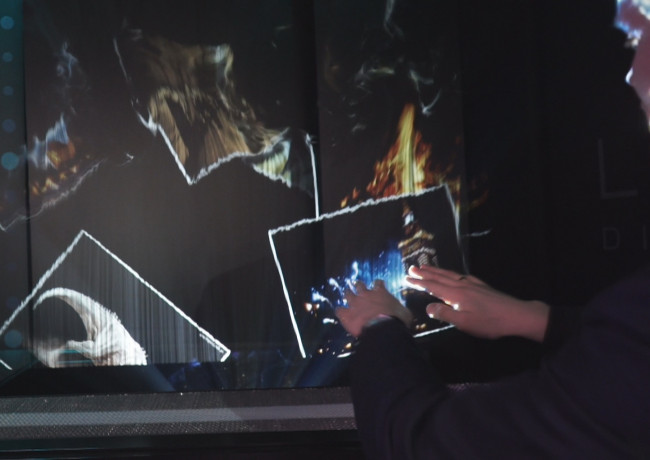
Milestone had a combined booth for its three brands, Da-Lite, Chief and Projecta. The main item of interest to our readers is the new Da-Lite FastFold NXT front projection screen. This uses a demountable frame and is intended for staging events. The screen ‘wraps around’ the frame completely and has special fasteners that simply clip into the frame moulding. This means that the front of the display is very ‘clean’ and has no visible signs of the fasteners – it is also held very flat. The screen has a very uniform and smooth surface so it is suitable for high resolution images including UltraHD and 4K. The screen will be officially launched at Infocomm, when it will start shipping.
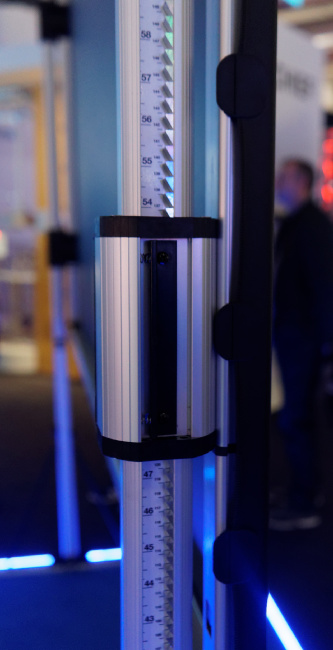
Panasonic was demonstrating its range of projection and flat panel solutions. The projectors were being demonstrated with the ‘Mirror Head’ system developed by Austrian start-up, Dynamic Projection Institute (DPI) which told us that it has been getting a lot of coverage recently (we reported on the technology from ISE and the Retail DSE in London, where Optoma was using the system to advantage). DPI told us that while the mechanics of the system were relatively simple, the key to successful use is in the software which needs to be able to control the mirror motion and alignment in synchronisation with the main display content. This is handled by the firm’s MDC-X media server system which allows transformation and warping as well as control of a range of different media playback and projector control. Panasonic had a miniaturised version of the recent big projection mapping project in Russia.
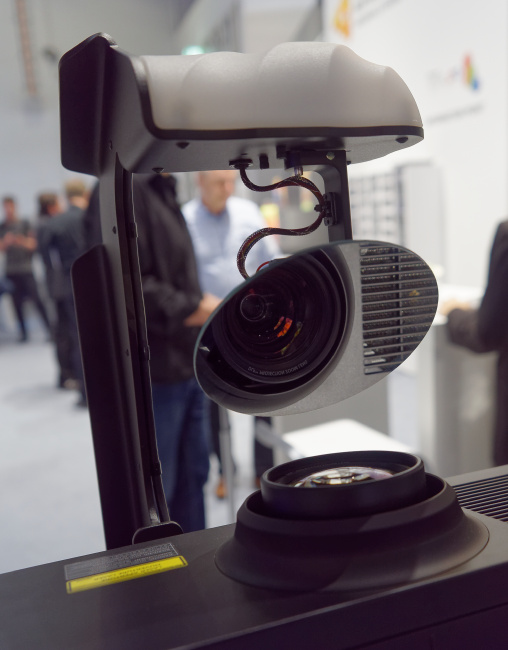
Project:Syntropy is a German systems integrator that specialises in domes and immersive environments for simulation and entertainment. It has its own blending and warping technology and was demonstrating how a dome projection system could be very accurately and automatically aligned using a system of cameras mounted around the edge of the dome. The company told us that it could also do this kind of alignment using a single ‘fish eye’ lens on a camera, but told us that, very often, it is impossible to put a camera in the middle, whereas it is usually not a problem to mount the cameras around the edges. We expect to see the company again at the ITSEC show in June. An affiliated company, Dome Projection, has developed the software for the system alignment.
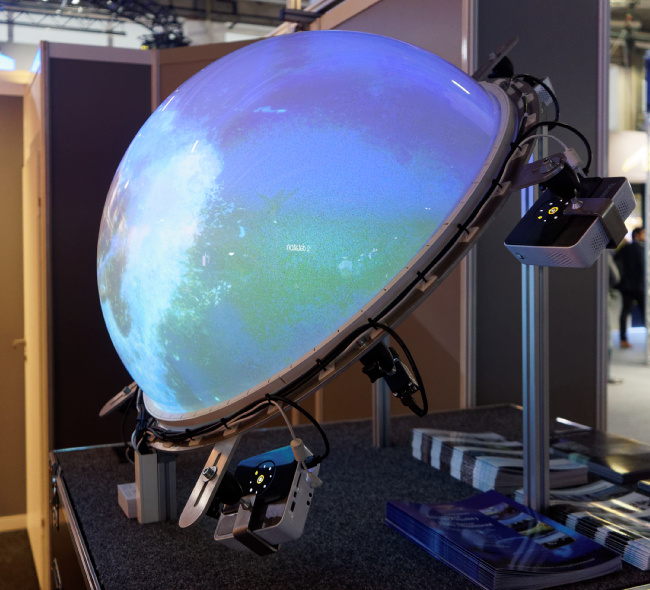 Project:Syntropy has alignment systems for domes and caves. Image:Meko
Project:Syntropy has alignment systems for domes and caves. Image:Meko
A number of companies were listed as being at the show that we hoped to get something from, but Atomos, BlackMagic, Sony and Canon were all in a single area devoted to motion video. Sony and Canon were highlighting their camera systems and were not talking about displays.
Shenzen Chip Optech was showing 4mm outdoor LEDs with >6,000 cd/m² and also had 2.97mm indoor variations. The company told us that it has an office in Germany.

